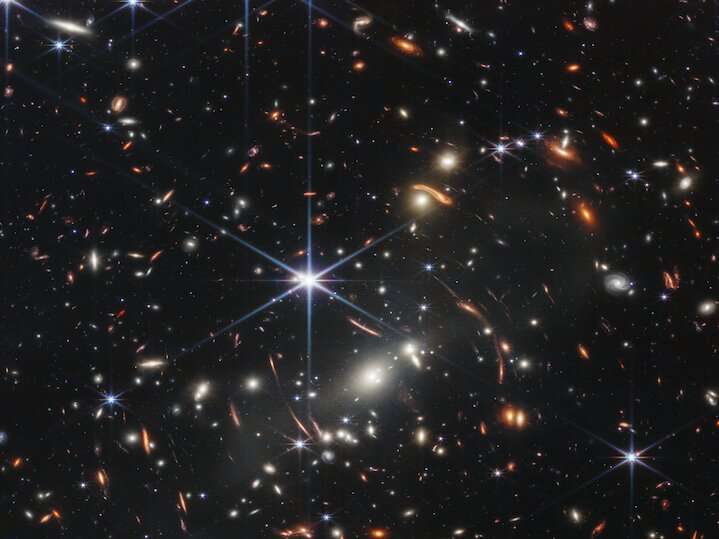Credit: NASA
The first images from NASA’s new space telescope unveiled this week include a new look at the universe, expanding our view of the galaxy as we know it. The images contain a high-resolution “window” to millions of stars through the Milky Way’s dust, a new look at galaxies that are for the first time in 30 years light-years away. LSU astrophysicists share their reactions to the photos and how the Webb telescope will impact future research and discovery.
What is the meaning of these photos?
“These images are the first scientific results from Webb, a successor to Hubble, and represent the product of two decades of work by scientists at NASA, ESA and CSA. Each of the five in the initial release comes from only the first week of observations. are not only breathtaking, they foreshadow the results Webb will make possible in the next decade,” said LSU astrophysicist Eric Burns.
Will this change the way scientists look at space? What does it mean for the world of science?
“The infrared light Webb sees allows us to study the first galaxies, the atmospheres of planets in our solar system and in other solar systems, and to understand how stars form and evolve. It will revolutionize our understanding of many topics in astrophysics from the evolution of the universe to the forging of the elements. Webb’s abilities will also reveal unknown and unexpected findings that will take years to understand,” Burns says.
“Webb is enabling so much new science that it’s hard to know where to start. Studying the ultraviolet light of the early galaxies is what it was designed for, but the high-resolution images of millions of stars through the dust of the Milky Way, and are I am most interested in spectroscopic studies of molecules in the atmospheres of exoplanets,” says LSU Professor of Physics and Astronomy Matthew Penny.
What do these photos mean to the average person?
“Hubble has stood on its own as the single largest tool for scientific engagement with the public. The images have spawned a generation of STEM individuals who continue to play their vital role in advancing and improving society as a whole. Hubble helped us understand our place in the universe, how we got here and where we’re going. Webb is the successor. Scientifically it will pick up where Hubble and other telescopes have taken us, and its images and scientific breakthroughs will inform current and future scientists continue to inspire, engineers and educators,” says Burns.
“Astronomy, the stars, planets and galaxies are perhaps second only to the heart as a cultural link to the world of science and probably has been since man became aware. The subject interests almost everyone, and the images and references to it , are scattered across every form of human cultural expression: literature, music, theater and film, and painting, photography and ceramics.This new observatory offers us a new way to view the universe with colorful, high-resolution infrared images and on every image not only that, it will enable scientists to answer fundamental questions about our universe and how it evolved to be hospitable to our existence, and of course raise a whole host of new questions for the next generations of scientists to to answer,” says Penny
What do you think is the most interesting thing about the photos?
“My area of research focuses on gamma rays and gravitational waves, so I can enjoy these releases more as a member of the public. What struck me most was the comparison of the images from Webb and Hubble with the lensing of SMACS 0723. The angular resolution of the telescopes is pretty close, but the change in wavelength and collection area resulted in a huge improvement. When I dug up the Hubble image last night, the comparison just blew me away,” Burns says.
Could this be the first step to finding life in space?
“When Webb was first proposed, we had never seen an exoplanet, and when construction began, the study of exoplanets was still in its infancy. Now that it has been launched, there are more than 5,000 known exoplanets. Webb will be able to determine the atmospheres of some of these planets, their chemical composition, and even find evidence for clouds, such as on Earth. It will certainly revolutionize our understanding of the types of planets that may exist, with Kepler and TESS goals, but my personal opinion is that we’re lucky that Webb can prove the existence of extraterrestrial life, although many, more informed scientists disagree with me,” Burns says.
“Webb demonstrated the success of numerous technologies that would be used for that future telescope, and set us on a path to understand, ‘Are we alone?’ in my life.”
NASA releases ‘teaser’ image of James Webb telescope
Quote: Astrophysicists analyze the impact of newly released NASA images (2022, July 15) retrieved July 16, 2022 from https://phys.org/news/2022-07-astrophysicists-impact-newly-nasa-images.html
This document is copyrighted. Other than fair dealing for personal study or research, nothing may be reproduced without written permission. The content is provided for informational purposes only.

